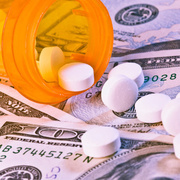HRSA Adds $5K Fines for 340B Prescription Drug Rate Overcharging
Under a new 340B Program rule, HRSA created penalties for drug companies who overcharge prescription drug rates and developed a ceiling price methodology for new drugs.

- Drug manufacturers participating in the 340B Drug Pricing Program who intentionally charge hospitals prescription drug rates higher than established ceiling prices will face a $5,000 penalty per instance, a new Health Resources and Services Administration (HRSA) final rule stated.

In addition to the penalty, drug manufacturers must refund overpayments to hospitals and other covered entities in the program.
The final rule also contained several other 340B Drug Pricing Program changes, including a new methodology for determining ceiling prices for new covered outpatient drugs and codification of the penny pricing policy.
Under the 340B Drug Pricing Program, certain healthcare providers and hospitals, such as critical access hospitals, rural healthcare facilities, and sole community hospitals, can obtain covered outpatient medications at discounted prices from drug manufacturers. The covered drugs include prescriptions and biologics other than vaccines and are typically physician-administered.
Drug manufactures in the program must abide by ceiling prices for covered drugs established by the HRSA. The maximum price a manufacturer can charge hospitals is based on the average manufacture price and its unit rebate amount.
Manufacturers are also incentivized to participate in the program despite lower prescription drug rates because Medicaid will cover their medications.
In 2015 alone, the program saved 340B Drug Price Program hospitals and providers about $6 billion, HRSA reported in the final rule.
However, the program did not have an adequate administrative dispute resolution process for hospitals that experienced prescription drug rate overcharges, the American Hospital Association claimed in October 2016.
The hospital group urged HRSA to give hospitals more access to prescription drug rate data and require manufacturers to fulfill information requests for price data during the dispute process.
Under the final rule, HRSA boosted overcharge regulations beyond just imposing financial penalties on manufacturers that up-charge hospitals. The organization also decided to finalize a new system for establishing prescription drug rates for new covered outpatient prescriptions.
New drugs oftentimes do not have sufficient data to calculate a ceiling price because prices are set using data from the preceding calendar year.
However, the new rule will require drug manufacturers to estimate 340B ceiling prices for new drugs based on the difference between the drug’s wholesale acquisition cost and the appropriate rebate percentage. Rebates include 23.1 percent for many single-source innovator drugs, 17.1 percent for clotting factors and drugs approved exclusively for pediatric care, and 13 percent for generics.
Once the average manufacturer price for new drugs is found, HRSA mandated that manufacturers determine actual 340B ceiling prices based on the average manufacturer price for the time under which the ceiling price was estimated. The manufacture price, however, must be determined no later than the fourth quarter that the drug was available for sale.
In the event the estimated and actual 340B ceiling prices are different and resulting in an overcharge, manufacturers must refund hospitals within 120 days of an overcharge determination.
However, hospitals and manufacturers can decide that the prescription drug rate difference is not significant enough to warrant repayment. Alternatively, hospitals and manufacturers can also agree to other payment options, such as netting or crediting.
Additionally, the recent HRSA rule codified the penny pricing policy. For some drugs, the unit rebate amount and the average manufacturer price are equal, resulting in a ceiling price of zero.
However, the 340B Drug Pricing Program requires some payment for covered outpatient drugs. Some health IT systems also cannot generate invoices or electronic data interchange price updates for prices less than a penny.
To overcome the challenges, many manufactures charge $0.01 for drugs that have a zero or less than a penny ceiling prices.
The new rule codifies the policy in the program because the “long-standing policy reflects a balance between the equities of different stakeholders and establishes a standard pricing method in the market.”
340B Drug Pricing Program participants can expect the new changes to take effect on April 1.
Dig Deeper:
• Would Proposed Value-Based Reimbursements Reduce Drug Costs?
• Preparing the Healthcare Revenue Cycle for Value-Based Care
